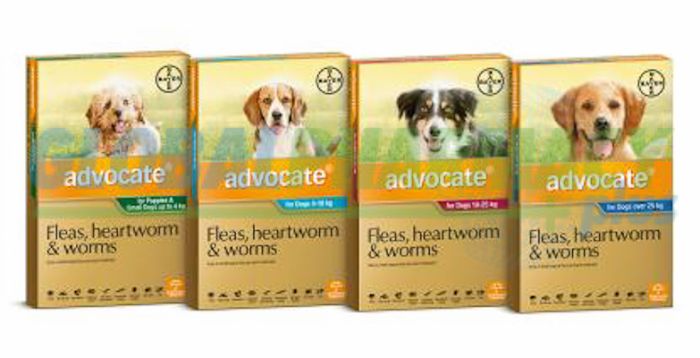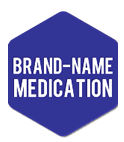Advantage Multi® - Advocate for Dogs
Quick Overview
Advantage Multi,- Advocate for Dogs this Brand Name product is manufactured by Bayer Animal Health
We carry Brand Name Advantage Multi - Advocate for Dogs in
- Pipette Applicator form
| BRAND Products | Your Price | |
|---|---|---|
| $51.00 | |
| $51.00 | |
| $51.00 | |

Buy Advantage Multi - Advocate for Dogs at Global Pharmacy Plus with confidence knowing that your are buying brand name Advantage Multi manufactured by Bayer Animal Health that has been sourced in Europe. Advantage Multi is the same as product Advocate by Bayer. Advantage Multi is known in the USA, outside the USA Advantage Multi is called Advocate. The cost of Advantage Multi is less expensive in Europe and we are passing on the savings to you. Advocate for Dogs is a clear yellow to brownish solution containing 10 % imidacloprid and 2.5 % moxidectin with benzyl alcohol and Butylhydroxytoluene 1 mg/ml (E 321). The products are presented in a single use plastic pipette for cutaneous (spot-on) treatments. Each pipette contains either 0.4 ml (40 mg imidacloprid, 10 mg moxidectin), 1.0 ml (100 mg imidacloprid, 25 mg moxidectin), 2.5 ml (250 mg imidacloprid, 62.5 mg moxidectin) or 4.0 ml (400 mg imidacloprid, 100 mg moxidectin). Uses; For use in dogs suffering from, or at risk from, mixed parasitic infections: For the treatment and prevention of flea infestation (Ctenocephalides felis), treatment of ear mite infestation (Otodectes cynotis) and prevention of heartworm disease (L3 and L4 larvae of Dirofilaria immitis) and for the treatment of biting lice (Trichodectes canis), sarcoptic mange (caused by Sarcoptes scabiei var. canis), demodicosis (caused by Demodex canis), prevention of heartworm disease (L3 and L4 larvae of Dirofilaria immitis) and angiostrongylosis (L4 larvae and immature adults of Angiostrongylus vasorum). Treatment of Angiostrongylus vasorum and Crenosoma vulpis and treatment of infections with gastrointestinal nematodes (L4 larvae, immature adults and adults of Toxocara canis, Ancylostoma caninum, Uncinaria stenocephala and adults of Toxascaris leonina and Trichuris vulpis). The recommended minimum doses of advocate for dogs are 10 mg/kg body weight imidacloprid and 2.5 mg/kg body weight moxidectin, equivalent to 0.1ml/kg body weight Advocate for dogs. One treatment prevents future flea infestation for 4 weeks. Existing pupae in the environment may emerge for 6 weeks or longer after treatment is initiated, depending upon climatic conditions. Therefore, it may be necessary to combine Advocate treatment with environmental treatments aimed at breaking the flea life cycle in the surroundings. This can result in a more rapid reduction in the household flea population. The product should be administered at monthly intervals when used as part of a treatment strategy for flea allergy dermatitis. Treatment of ear mite infestation (Otodectes cynotis). In dogs, loose debris should be gently removed from the external ear canal at each treatment. For both cats and dogs, a further veterinary examination 30 days after treatment is recommended as some animals may require a second treatment. Do not apply directly to the ear canal. Treatment of biting lice (Trichodectes canis) A single dose should be administered. A further veterinary examination 30 days after treatment is recommended as some animals may require a second treatment. Treatment of sarcoptic mange (caused by Sarcoptes scabiei var. canis) A single dose should be administered twice 4 weeks apart. Treatment of demodicosis (caused by Demodex canis) The administration of a single dose every 4 weeks for 2 to 4 months is efficacious against Demodex canis and leads to a marked improvement of clinical signs particularly in mild to moderate cases. Especially severe cases may require more prolonged and more frequent treatment. To achieve the best possible response in these severe cases, at the discretion of the veterinarian, Advocate can be applied once a week and for a prolonged time. In all cases it is essential that the treatment should be continued until skin scrapings are negative on at least 2 consecutive monthly occasions. Treatment should be stopped in dogs that show no improvement or do not respond in mite count after 2 months treatment. Alternative treatment should be administered. Seek the advice of your veterinarian. Heartworm prevention in dogs; dogs in areas endemic for heartworm, or those which have travelled to endemic areas, may be infected with adult heartworms. Therefore prior to treatment with Advocate for dogs, the advice provided in Contra-Indications and Warnings etc should be considered. For prevention of heartworm disease, the product must be applied at regular monthly intervals during the time of the year when mosquitoes (the intermediate hosts which carry and transmit heartworm larvae) are present. The product may be administered throughout the year or at least 1 month before the first expected exposure to mosquitoes. Treatment should continue at regular monthly intervals until 1 month after the last exposure to mosquitoes. To establish a treatment routine, it is recommended that the same day or date be used each month. When replacing another heartworm preventative product in a heartworm prevention program, the first treatment with Advocate must be given within 1 month of the last dose of the former medication. In non-endemic areas there should be no risk of animals having heartworm. Therefore they can be treated without special precautions. Treatment of Angiostrongylus vasorum in dogs, A single dose should be administered. A further veterinary examination 30 days after treatment is recommended as some animals may require a second treatment. In endemic areas regular four weekly application will prevent angiostrongylosis and patent infection with Angiostrongylus vasorum. Roundworm, hookworm and whipworm treatment in dogs; In areas endemic for heartworm, monthly treatment may significantly reduce the risk of re-infection caused by the respective round-, hook- and whipworms. In areas non-endemic for heartworm, the product can be used as part of a seasonal prevention program against fleas and gastrointestinal nematodes. Studies have shown that monthly treatment of dogs will prevent infections caused by Uncinaria stenocephala . Method of administration. For external use only. Remove one pipette from the package. Then hold the pipette in an upright position, and twist and pull off the cap. Reverse the cap and use it to twist and remove the seal from the pipette. With the dog in a standing position, part the coat between the shoulder blades until the skin is visible. Wherever possible apply to undamaged skin. Place the tip of the pipette on the skin and squeeze the pipette firmly several times to empty its contents directly onto the skin. For dogs, the Advocate for dogs, which contains 10 % imidacloprid and 2.5 % moxidectin, must be used. The product tastes bitter. Salivation may occasionally occur if the animal licks the application site immediately after treatment. This is not a sign of intoxication and disappears within some minutes without treatment. Correct application will minimize licking of the application site. Care should be taken that the contents of the pipette or the applied dose does not come into contact with the eyes or mouth of the recipient and/or other animals. Do not allow recently treated animals to groom each other. When the product is applied in 3 to 4 separate spots in larger dogs, specific care should be taken to prevent the animal licking the application sites. During treatment with Advocate no other anti-parasitic macrocyclic lactone should be administered. This product contains moxidectin (a macrocyclic lactone), special care should be taken with Collies, Old English Sheepdogs and related breeds or crossbreeds, to correctly administer the product as described above. In particular, oral uptake by the recipient and/or other animals should be prevented. Ivermectin-sensitive Collie dogs tolerated up to 5 times the recommended dose repeated at monthly intervals without any adverse effects, but the safety of application at weekly intervals has not been investigated in ivermectin-sensitive Collie dogs. When 40% of the unit dose was given orally, severe neurological signs were observed. Oral administration of 10% of the recommended dose produced no adverse effects. Further information; Imidacloprid, 1-(6-Chloro-3-pyridylmethyl)-N-nitro-imidazolidin-2-ylideneamine is an ectoparasiticide belonging to the chloronicotinyl group of compounds. Chemically, it is more accurately described as a chloronicotinyl nitroguanidine. Imidacloprid is effective against larval flea stages and adult fleas. Flea larvae in the pet’s surroundings are killed after contact with a pet treated with the product. Imidacloprid has a high affinity for the nicotinergic acetylcholine receptors in the post-synaptic region of the central nervous system (CNS) of the flea. The ensuing inhibition of cholinergic transmission in insects results in paralysis and death. Due to the weak nature of the interaction with mammalian nicotinergic receptors and the postulated poor penetration through the blood-brain barrier in mammals, it has virtually no effect on the mammalian CNS. Imidacloprid has minimal pharmacological activity in mammals. Moxidectin, 23-(O-methyloxime)-F28249 alpha is a second-generation macrocyclic lactone of the milbemycin family. It is a parasiticide which is active against many internal and external parasites. Moxidectin is active against larval stages (L3, L4) of Dirofilaria immitis. It is also active against gastrointestinal nematodes. Moxidectin interacts with GABA and glutamate-gated chloride channels. This leads to opening of the chloride channels on the postsynaptic junction, the inflow of chloride ions and induction of an irreversible resting state. The result is flaccid paralysis of affected parasites, followed by their death and/or expulsion. After topical administration of the product, imidacloprid is rapidly distributed over the animal’s skin within one day of application. It can be found on the body surface throughout the treatment interval. Moxidectin is absorbed through the skin, reaching maximum plasma concentrations approximately 1 to 2 days after treatment in cats and approximately 4 to 9 days after treatment in dogs. Following absorption from the skin, moxidectin is distributed systemically and is slowly eliminated from the plasma as manifested by detectable moxidectin concentrations in plasma throughout the treatment interval of one month. As always we back our products by a 100% Money Back Guarantee!
| Med Type Brand Name | 1 |
|---|---|
| Rx Req | 1 |






